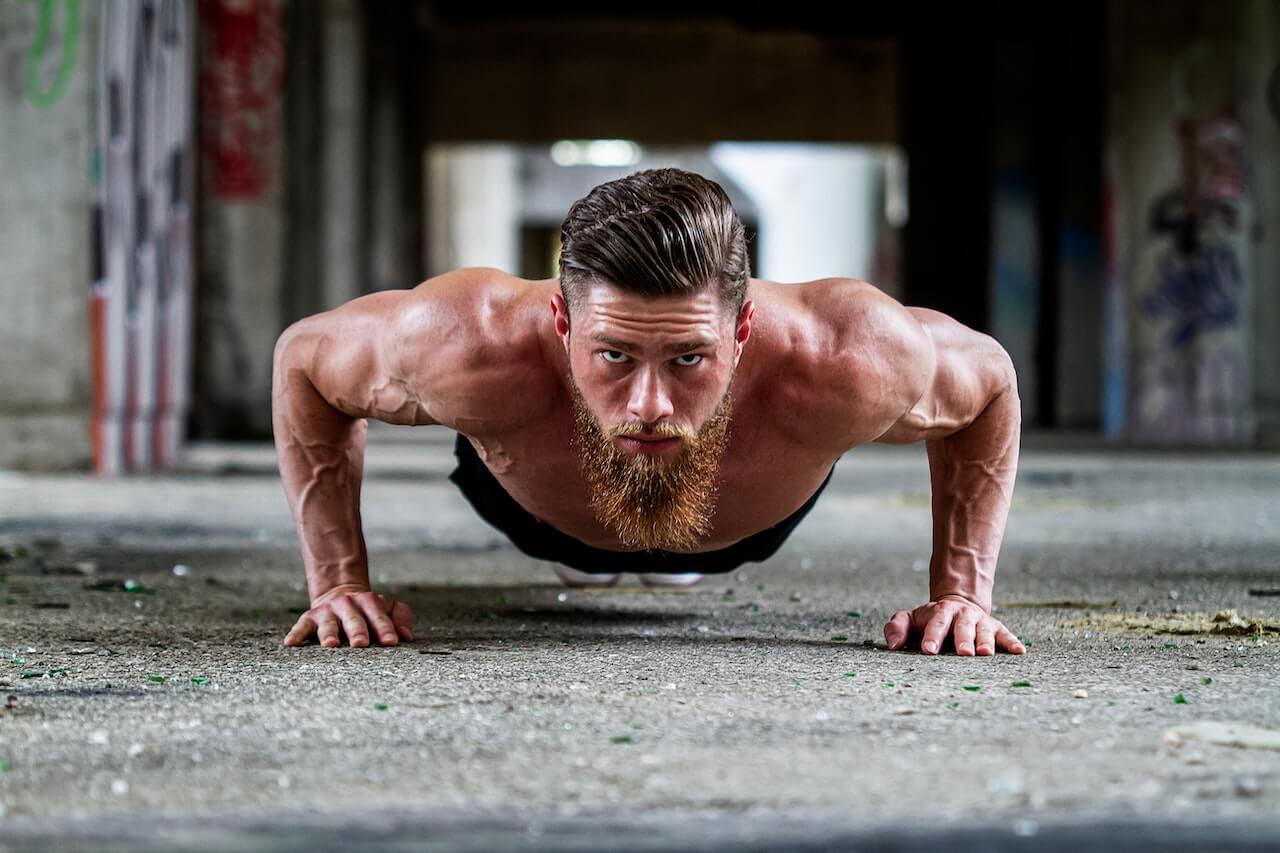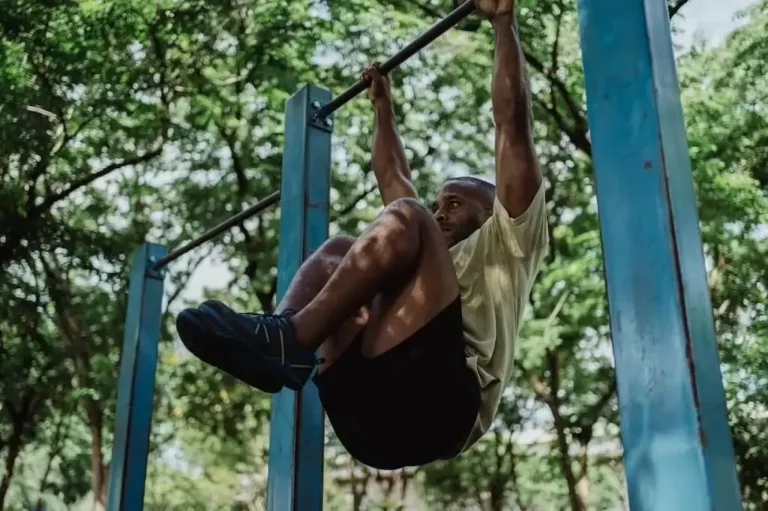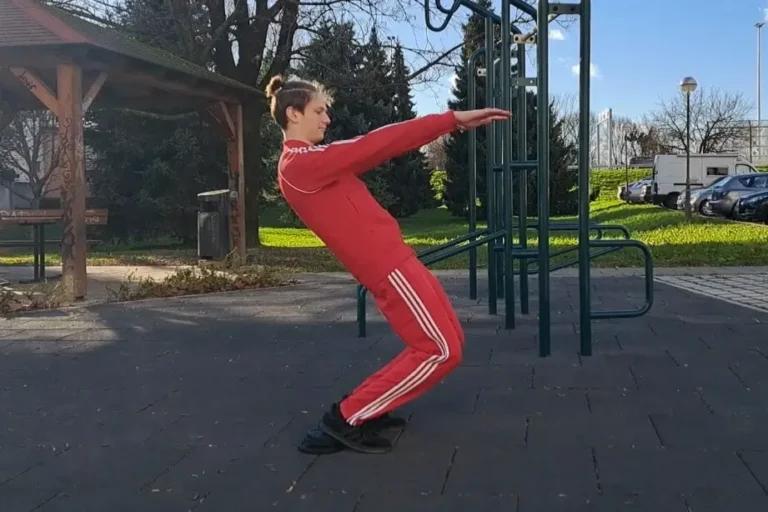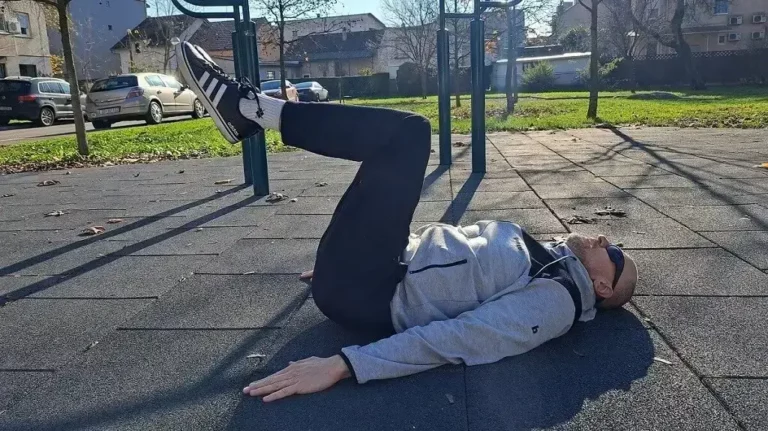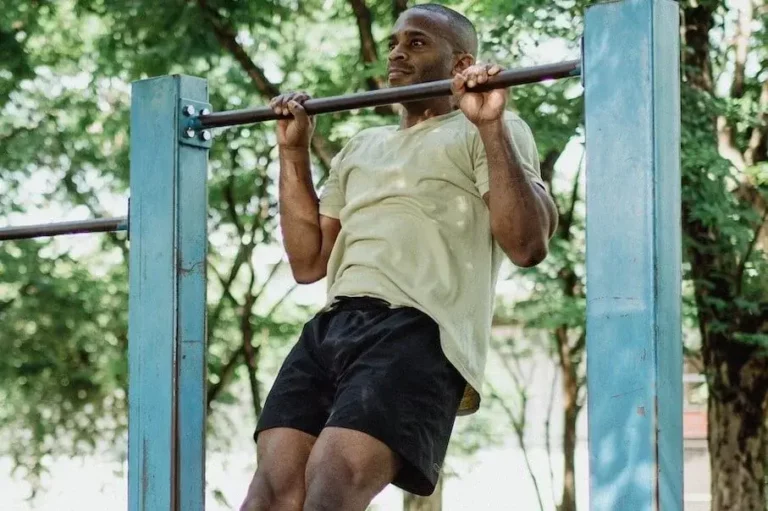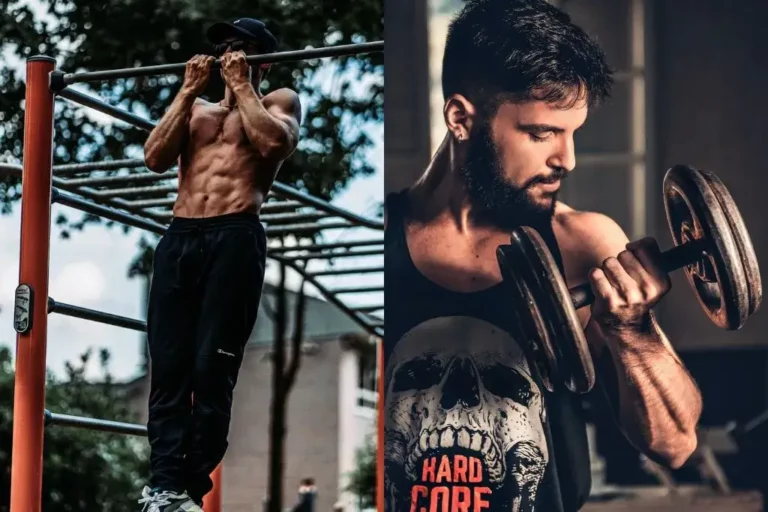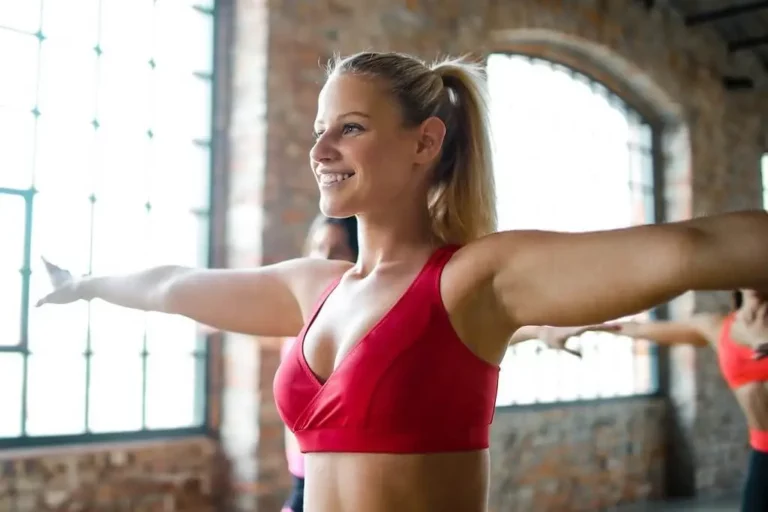Complete Push Workout With Sets And Reps
A push workout is usually an important part of a push/pull/leg split. However, it can also be used on its own in some cases.
Push workout will help you develop your chest, triceps, and shoulder muscles.
This is what makes this workout an important part of your training arsenal.
Primary muscles worked in a push workout
Push workout is designed to use push motion for all exercises in a workout. It’s the opposite of a pull workout which is all about pulling.
Push workout – primary muscles worked:
- Chest (pectoralis major)
- Triceps (triceps brachii)
- Shoulders (deltoid)
Push workout equipment
This workout is great because you can do an entire training session without any equipment at all. You can do it at your home when you are traveling or even at work.
However, to get the most out of a push workout some equipment will help you do more exercises. It will give you more variation and help you target the same muscle groups from various angles.
This will help increase time under tension and add to your muscle growth.
Equipment:
- Low bar
- Dip bars
- Bench (or other elevated surface)
Complete Push Workout
This workout starts with harder exercises at the beginning and progresses to easier ones at the end. It will allow you to do more reps throughout the training.
If you start with easier exercises at the beginning you will do much fewer reps on harder exercises at the end of the workout.
Push-up workout routine:
- Chest and triceps
- 3×5-10 straight bar dips
- Chest
- 3×5-10 archer push-ups
- Triceps
- 3×8-12 dips
- Shoulders
- 3×5-10 handstand push-ups (against the wall)
- Triceps
- 3×15-20 bench dips
- Chest
- 3×8-15 push-ups
- Shoulders
- 3×10-15 pike push-ups
- Chest
- 3×10-15 incline push-ups
This workout alternates between chest, triceps, and shoulder exercises. The idea behind this is not to overload the same muscle group set after set.
If you worry about overloading or underdeveloping some muscle groups, you may consider using a workout program. When using a workout program, everything is preset for you. You just have to show up and do the work.
Push Workout: Muscles Involved
When you want to work on specific muscle groups it’s beneficial to know where they are located and what their function is.
Here we are talking about chest, shoulder, and triceps muscles. Let’s examine those muscles a little closer.
Chest Muscle
If you want to know which chest muscles are working on specific exercises it’s good to know their anatomy.
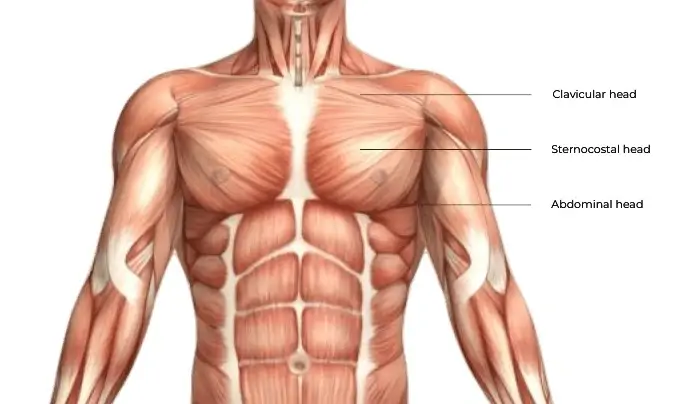
Chest muscle consists of three parts:
- Clavicular head (upper chest)
- Sternocostal head (lower and mid-chest)
- Abdominal head (lower chest)
The clavicular head of a chest muscle (upper chest) attaches to a clavicle (collar) bone on one side and a humerus (upper arm) bone on the other.
The sternocostal head of a chest muscle (lower and mid-chest) attaches to the sternum (breast) bone and ribs on one side and the humerus (upper arm) bone on the other.
The abdominal head of a chest muscle (lower chest) attaches to the anterior layer of the rectus sheath on one side and the humerus (upper arm) bone on the other.
Chest muscle function
The main function of the chest muscle is the adduction and internal rotation of your arm in the shoulder joint.
The clavicular head flexes and extends your arm up to a 90-degree angle.
The sternocostal head extends flexed arm by pulling it down.
Triceps Muscle
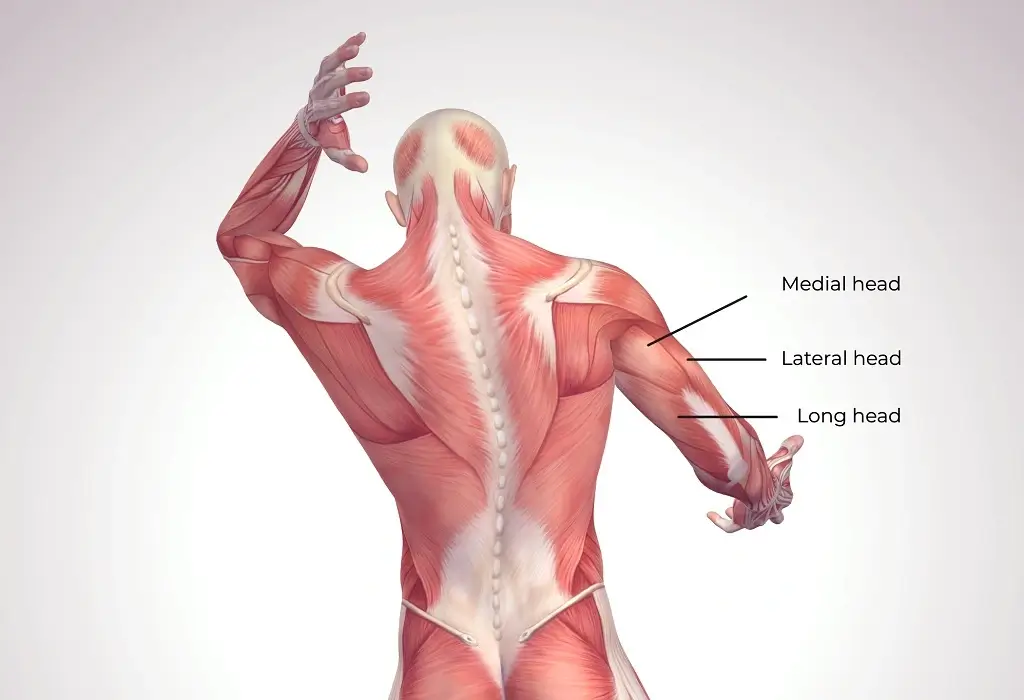
The anatomy and function of a triceps muscle is pretty simple.
Triceps has three heads:
- Lateral head
- Medial head
- Long head
The long head is the inner portion of the triceps muscle and is closest to your body. It attaches to your shoulder blade (more precisely at the infraglenoid tubercle of the scapula) and adds to shoulder stability.
The lateral head is the outer portion of your tricep and is located on the outer part of your arm. It attaches to the outer part of the humerus (your arm bone).
The medial head is located beneath the long and lateral heads. Its upper part attaches to the back side of the humerus.
All three heads attach through the same tendon to your elbow.
Triceps function
The main function of the triceps is the extension of your forearm at the elbow.
The long head of the triceps also helps with the extension and adduction of your arm at your shoulder. It’s because this head is the only one attached to your shoulder blade.
Shoulder Muscles
Shoulder muscles consist of two muscle groups:
- Anterior axio-appendicular muscles
- Posterior axio-appendicular muscles
But, when used in the fitness industry we are almost exclusively talking about deltoid muscle.
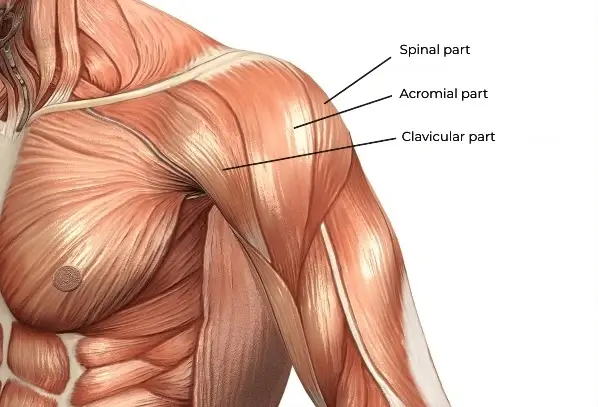
The deltoid muscle consists of three parts:
- Clavicular part (front deltoid)
- Acromial part (side deltoid)
- Spinal part (rear deltoid)
In the fitness industry, the clavicular part is called the front deltoid, the acromial part is called the side deltoid and the spinal part is called the rear deltoid.
Front deltoid is attached to your clavicle (collar) bone and hence the name – clavicular.
The side deltoid attaches to the acromion bone.
The rear deltoid is attached to the spine of your scapula (shoulder blade).
All three parts of the deltoid are attached to your upper arm bone – humerus.
Deltoid function
The main function of the deltoid muscle is moving your arm in all directions in the shoulder joint.
The front deltoid’s primary functions are flexion and internal rotation of the arm. So, it raises and rotates your arm in front of you.
Side deltoid raises your arm to the side.
The rear deltoid extends and externally rotates your arm.
Straight Bar Dips
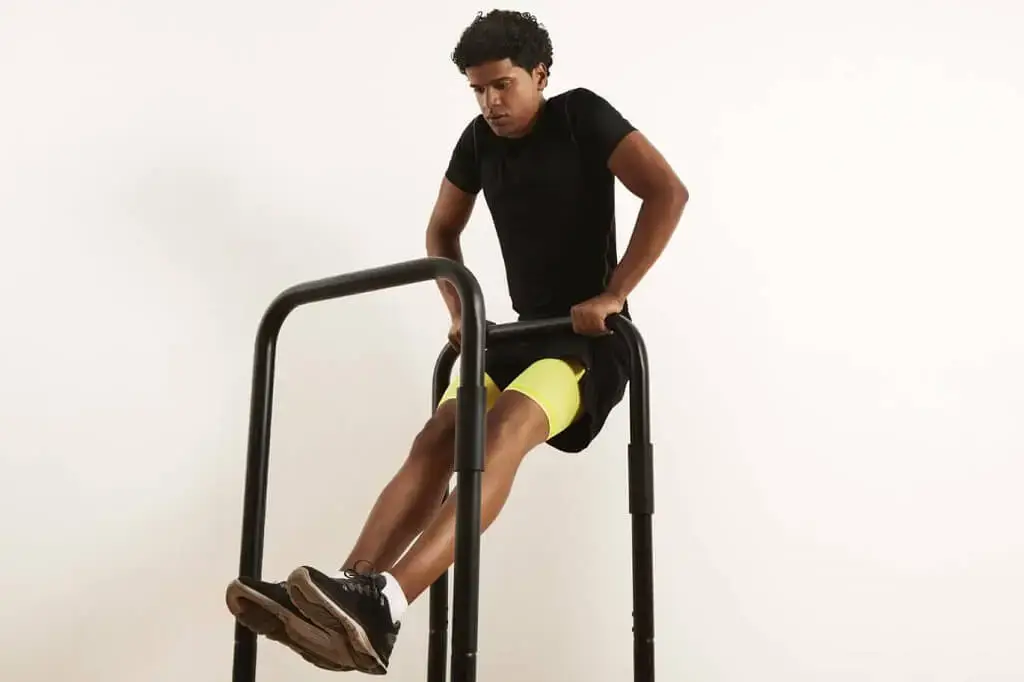
Straight bar dips are an excellent exercise for working both your chest and triceps.
Interestingly, the move you are performing in this exercise is the same as the move performed in the last portion of a muscle up. So, if you are in pursuit of your first muscle up, this exercise will be an excellent addition to your workouts.
Straight bar dips muscles worked:
- Chest
- Triceps
- Shoulders
Equipment:
- Dip bars (or low bar)
How to perform straight bar dips
Positioning:
You start by grabbing a bar with your palms facing away from you.
Depending on the height of the bar you have access to you might need to jump up to a bar to get to a starting position.
Jump up to a bar so that your arms are holding to a bar straight down to your sides. Your arms are holding your entire weight with your feet not touching the ground.
Your hips are touching the bar. Keep your upper body straight while your legs are slightly bent in your hips.
Downward movement:
Lower yourself down by flexing your arms at your elbows. Keep lowering until your upper arm forms a 90 degrees angle with your forearms.
This is the lowest point of downward movement.
When lowering down, your upper body is leaning forward. Let your legs go forward under the bar so you can keep balance.
Don’t allow your upper body or your legs to touch the bar during the movement.
Upward movement:
To initiate upward movement push yourself up by straightening your arms in your elbows. Keep on pushing until your arms are straight. This is the highest point of upward movement.
During the entire movement concentrate on not touching the bar with anything but the hands that are grabbing the bar.
Archer Push Ups
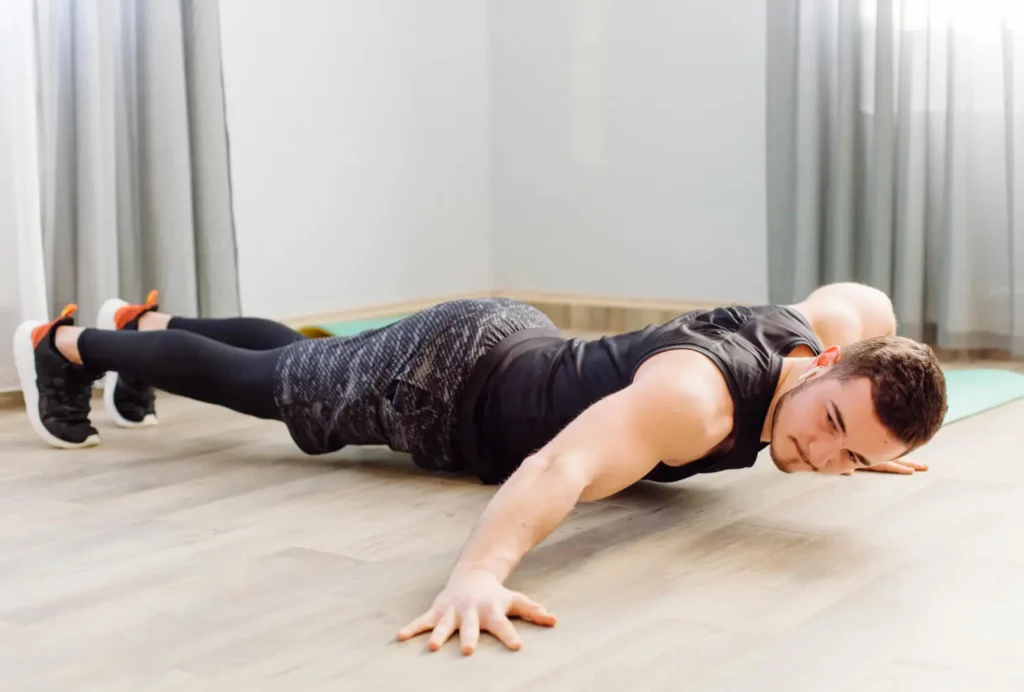
Archer push-ups are a more difficult variant of a normal push-up. Be careful when performing archer push-ups.
I’ve been reading about people who dislocated their shoulders when performing this exercise. Please, proceed with caution.
This exercise will load your muscles more than normal push-ups. Your triceps will work more on your bent arm while your front deltoid and bicep will work more on your straight arm.
Because of the increased load on your front deltoid on your straight arm, there is a danger of dislocating or otherwise harming your shoulder.
Archer push-ups muscles worked:
Primary
- Lower and mid-chest
- Front delts
- Triceps
Secondary
- Abs
- Lower back
- Biceps
Equipment:
- None
How to perform archer push-ups
Positioning:
Position your hands on the ground much wider than your shoulder width.
One of your arms will have to bend while you are moving down and be at around shoulder width. At the same time, your other arm will have to go straight to your side.
You should adjust your arm’s width to accommodate this requirement.
Your legs are on the floor touching the ground on your feet balls and your toes. Keep your entire body in a straight line by contracting your abs throughout the entire exercise.
Downward movement:
Lower yourself down by flexing one of your arms in your elbows. Target to touch the floor with your chest. Your other arm will go straight to your side (you will rotate this arm’s palm straight away from you).
When you touch the floor with your chest (or get to the floor as close as possible) this is the lowest point of downward movement.
Upward movement:
To initiate upward movement push yourself up from the floor by straightening your flexed arm in your elbow.
You will also start rotating the palm of your other arm (so it faces forward when you are in the upper position). Slowly get your body up. Keep on pushing until your arms are straight. This is the highest point of upward movement.
Dips
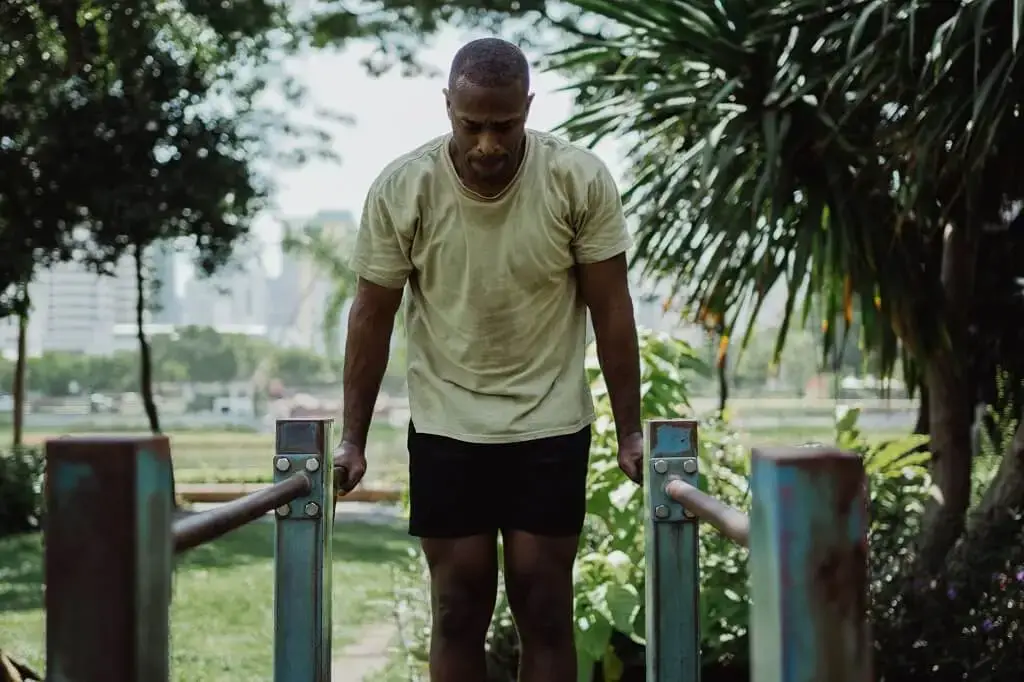
Dips are a great exercise to build your triceps. This exercise will also work your chest and shoulder muscles.
Dips muscles worked:
Primary
- Lower and mid-chest
- Front delts
- Triceps
Secondary
- Abs
Equipment:
How to perform dips
Positioning:
Grab dip bars with both hands. Keep straight as much as you can. Don’t allow your shoulders to come up to your ears during the exercise. Keep your shoulders depressed down the whole time.
Downward movement:
To initiate downward movement lower your body straight down by bending your elbows. Keep on lowering down until your upper arms form a 90-degree angle to your forearms. This is the lowest position of downward movement.
Don’t force yourself into this position at all costs. If your body is lacking strength and/or flexibility, allow yourself to go as deep as possible. Slowly work on your strength and flexibility until you can achieve your full range of motion.
Upward movement:
To initiate upward movement, push against the dip bars and start straightening your elbows. Keep on straightening your elbows until your arms are fully extended. This is the highest point of this movement.
Handstand Push Ups
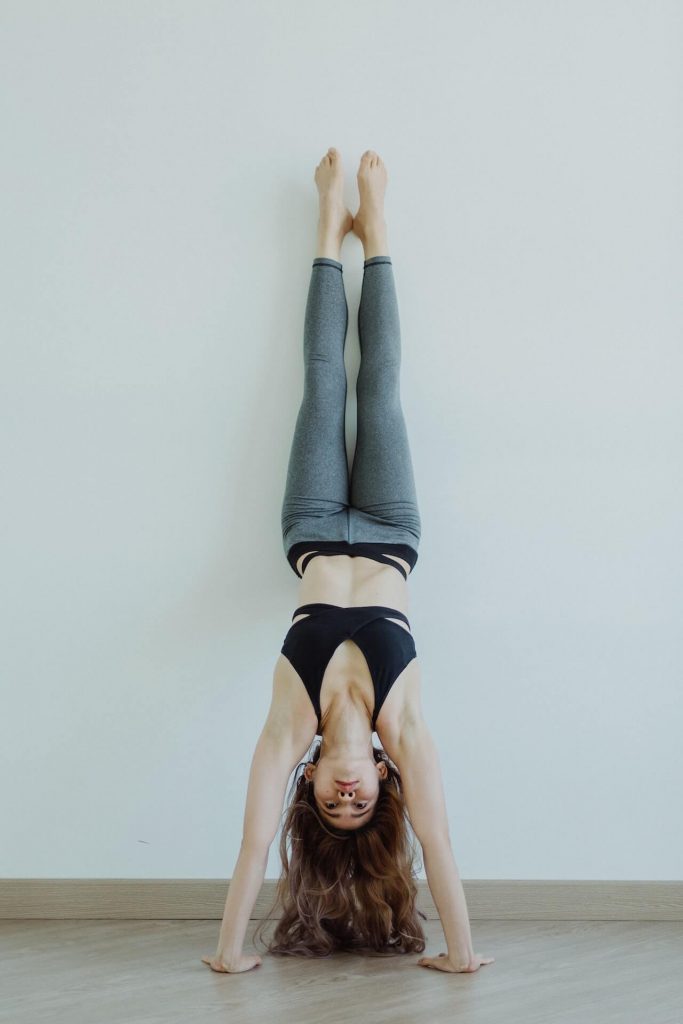
One of the harder exercises for building your deltoids is a handstand push-up. Ideally, you would perform freestanding handstand push-ups.
However, when you can’t balance your handstands perfectly, you can perform handstand push-ups against the wall.
Handstand push-ups muscles worked:
- Delts
- Traps
- Lats
- Chest
- Triceps
Equipment:
- Wall
How to perform handstand push-ups
Positioning:
Walk up the wall with your legs and move your hands one by one closer and closer to the wall. So when you are in a handstand you are facing the wall.
Your hands should be a few inches away from the wall. So you don’t fall on your back while doing handstand pushups.
Alternatively, you can kick up in a handstand against the wall so your face is away from the wall while you are doing handstand pushups. This position will strain your shoulders more, so the first variant is healthier.
Downward movement:
Lower your entire body down by flexing your arms in your elbows. Keep on lowering down as far as possible.
Concentrate on keeping your abs tight so your entire body is rigid and straight.
Upward movement:
Push yourself up by extending your arms at your elbows. Keep on pushing until your arms are completely straight.
Bench Dips
To perform bench dips you can use a bench or any other elevated surface to place your hands on. This exercise can be fine if you are careful how you are performing it. If you don’t you can hurt your shoulders.
How to avoid problems with your shoulders
It’s all about avoiding the internal rotation of your shoulders. One remedy is correcting the placement of your hands on the bench.
If you do this exercise with your hands facing forward (like most people do), you can hurt your shoulders. Your rotator cuff might get damaged with your shoulders internally rotated like this.
The simple remedy is to place your hands with your fingers facing away from you to the sides.
Another thing that is potentially dangerous is letting your shoulders collapse during the movement. This will also allow for internal shoulder rotation.
So, when you are performing the exercise concentrate on keeping your shoulders depressed. Concentrate on not allowing your shoulders to come up to your ears. Voila – problem solved!
Bench dips muscles worked:
- Triceps
- Chest
- Shoulders
Equipment:
- Bench (or other elevated surface)
How to perform bench dips
Positioning:
Place your hands on the edge of the bench with your fingers facing away from you to the side.
Keep your but off the bench so your entire upper body can lower down without touching the bench. Keep your legs straight with your toes facing forward.
Downward movement:
Lower down your butt by flexing your arms at your elbows. Keep on lowering down until your upper arm forms a 90-degree angle with your forearm.
This is the lowest position of the movement.
Upward movement:
To start moving up, push against the bench with your hands and extend your arms in your elbows. Keep on pushing until your arms are straight.
Concentrate on depressing your shoulders down throughout the movement.
If you let your shoulders come up to your ears it will allow internal rotation of your shoulders. This will put an unnecessary strain on your rotator cuffs.
Push Up
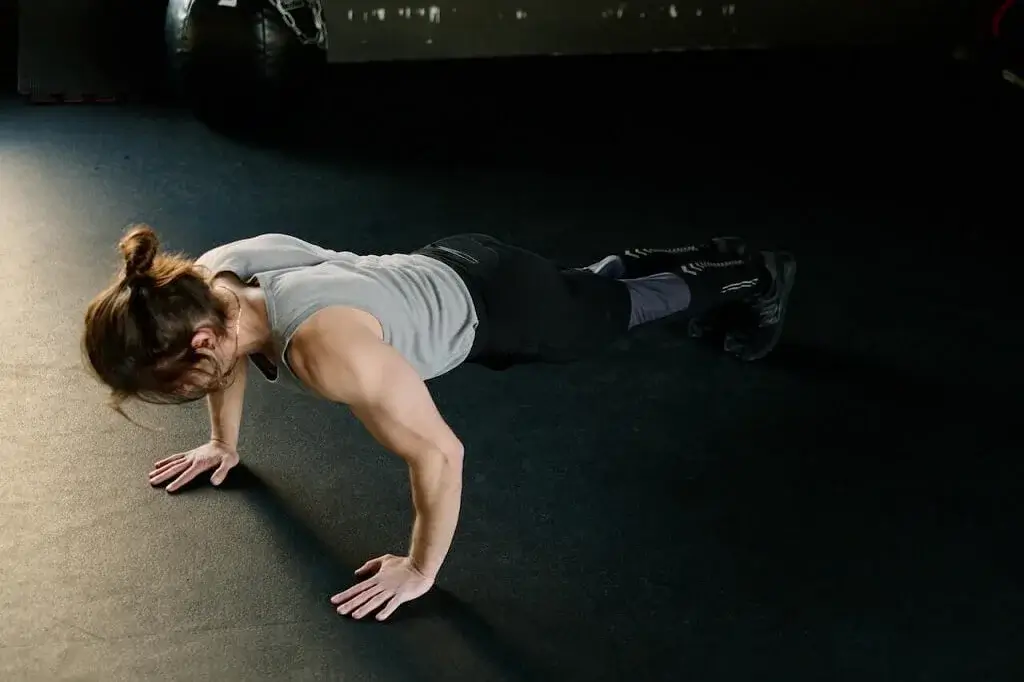
We all know push-ups pretty well and maybe even undervalue them. This can be an excellent exercise for developing your chest muscles. Especially if you concentrate on performing it dead correctly. Keeping the focus on extending time on the eccentric part of the movement (when you lower yourself down).
Push-ups muscles worked:
Primary
- Lower and mid-chest
- Front delts
- Triceps
Secondary
- Abs
- Lower back
Equipment:
- None
How to perform push-ups
Positioning:
Position your hands on the ground a bit wider than your shoulder width. Your legs are on the floor touching the ground on your feet balls and your toes.
Keep your entire body in a straight line by contracting your abs throughout the entire exercise.
Downward movement:
Lower yourself down by flexing your arms in your elbows, targeting to touch the floor with your chest.
When you touch the floor with your chest (or get to the floor as close as possible) this is the lowest point of downward movement.
Upward movement:
To initiate upward movement push yourself up from the floor by straightening your arms in your elbows. Keep on pushing until your arms are straight.
This is the highest point of upward movement.
Pike Push-Ups
Pike push-ups are another shoulder-targeting exercise. This is an easier variant than handstand push-ups.
- Delts
- Traps
- Lats
- Chest
- Triceps
Equipment:
- None
How to perform pike push-ups
Pike push-ups require a lot of flexibility. Especially in your hamstrings. If you are not able to perform pike pushups perfectly don’t worry. Do them as correctly as you possibly can.
Positioning:
Starting position of a pike push ups is very similar to a downward dog yoga pose. Stand straight with your feet around hip-width apart.
Place your hands on the floor in front of you. Your hips are up in the air and your palms and your feet are touching the ground.
Ideally, your upper body will be in a straight line and at a 90-degree angle to a floor. Go as close as you can to this perfect position.
Downward movement:
To lower down bend your arms in your elbows. Target with your head between your hands. Go down with your head directly to the imagined line connecting your hands.
Go as low as you can without feeling any pain.
Upward movement:
Push yourself up by extending your arms at your elbows. Keep on pushing until your arms are completely straight. You should be in the starting position again.
Incline Push Ups
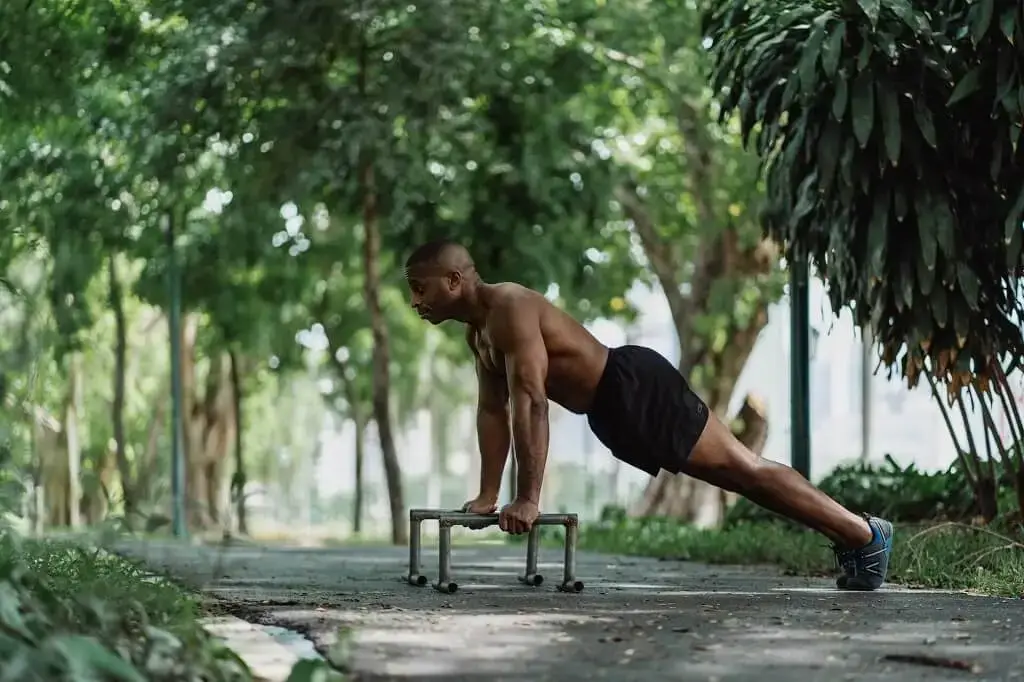
When performing incline pushups, you will feel predominantly your lower chest, front delts, and your triceps muscles working.
Incline push-up muscles worked:
Primary
- Lower and mid-chest
- Front delts
- Triceps
Secondary
- Abs
- Lower back
Equipment
- Bench (or any other elevated surface)
How to perform incline push-ups
You can perform incline pushups on any elevated surface you have access to. This may be a bench, box, bed, or chair.
Positioning:
Position your hands on the elevated surface a little bit wider than your shoulder width. Your legs are on the floor touching the ground on your feet balls and your toes.
Keep your entire body in a straight line by contracting your abs throughout the entire exercise.
Downward movement:
Lower yourself down by flexing your arms at your elbows. Target to touch the elevated surface with your chest.
When you touch the surface with your chest (or get to the surface as close as possible) this is the lowest point of downward movement.
Upward movement:
To initiate upward movement push yourself up from an elevated surface by straightening your arms in your elbows. Keep on pushing until your arms are straight. This is the highest point of upward movement.
Push Workout: Conclusion
Here you have it. A complete push workout with all sets and reps defined for you.
To avoid injury start with a warm-up and end a workout with a cool-down routine. This will make this workout complete.
So, you are set to go. Just do the work.

